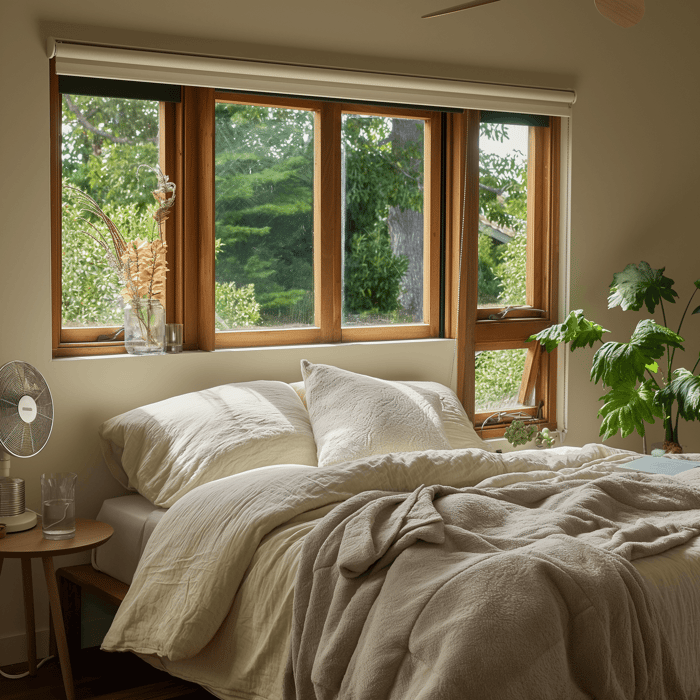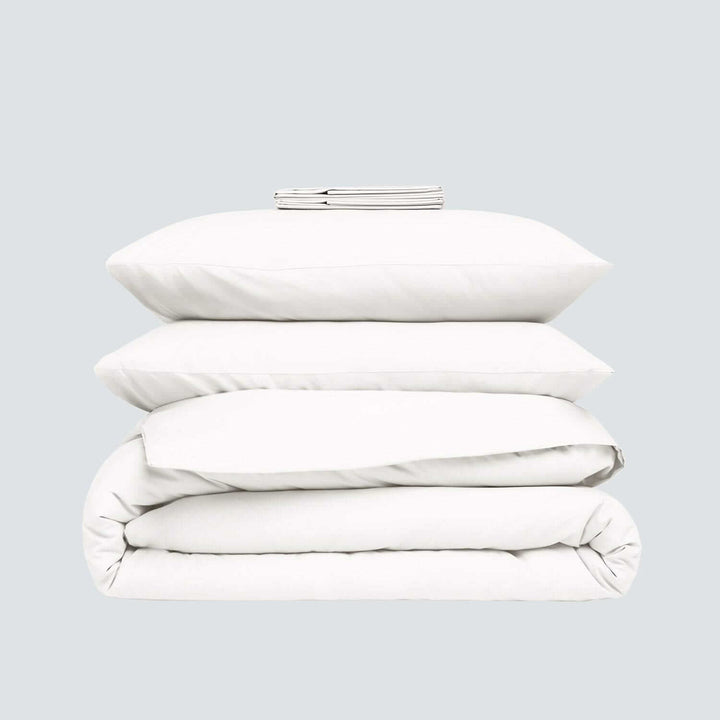Table of Contents
- What is breathable bedding — and why does it matter for your sleep?
- Comparison Chart: Breathable Materials vs Heat-Trapping Materials
- 1. Regenerative Wool (Best Overall for Cooling + Moisture Regulation)
- 2. Cotton Percale Sheets (Crisp, Lightweight, Highly Breathable)
- 3. Linen Bedding (Superior Airflow + Moisture Absorption)
- 4. Bamboo & Eucalyptus (Silky Cooling, Mixed Breathability)
- 5. Down & Down-Alternative (Breathable but Not Moisture-Wicking)
- Microfiber — The #1 Cause of Night Sweats
- Polyester & Polyester Blends — Zero Airflow, Maximum Heat
- Fleece & Plush Fabrics — Warm but Not Breathable
- The importance of breathable bedding for sleep
- How does breathability improve sleep quality?
- Different types of breathable materials
- Benefits of using breathable material
- Choosing the right breathable material for your needs
- Why Wool Is the Most Breathable Bedding Material (Explained Simply)
- Tips for maintaining breathable material
- Customer reviews and experiences
- Conclusion: The impact of breathability on sleep quality
- FAQs on Wool Duvet Inserts, Comforters & Sustainable Bedding
What is breathable bedding — and why does it matter for your sleep?
If you’re waking up sweaty, restless, or overheated, your bedding—not your body—is usually to blame. Breathable bedding is designed to move air, wick away moisture, and keep your temperature steady all night.
The right cooling bedding can create a dry, comfortable sleep climate, especially if you struggle with night sweats, hot flashes, or simply run warm.
But not all “cooling” fabrics actually work.
Some materials trap heat, others hold humidity, and many “breathable” claims are just marketing.
Below, we break down the best temperature-regulating bedding, the most effective lightweight materials, and the types of bedding you should avoid if you’re serious about staying cool. Whether you’re looking for a breathable comforter, breathable bed sheets, or a full hot-sleepers setup, here’s what actually delivers, and why breathable bedding for night sweats isn’t a luxury — it’s a sleep essential.
Comparison Chart: Breathable Materials vs Heat-Trapping Materials
| Material | Breathability | Heat Regulation | Best For |
|---|---|---|---|
| Wool | ⭐⭐⭐⭐⭐ | ⭐⭐⭐⭐⭐ | Hot sleepers |
| Cotton | ⭐⭐⭐⭐ | ⭐⭐⭐ | All seasons |
| Down alternative | ⭐⭐ | ⭐ | Budget sleepers |
| Microfiber | ⭐ | ⭐ | Don’t use if you run hot |
Best Breathable Bedding Options (Ranked for Hot Sleepers)
1. Regenerative Wool (Best Overall for Cooling + Moisture Regulation)
Wool is the gold standard for temperature-regulating bedding. Its naturally crimped fibers create tiny air pockets that support airflow and pull moisture vapor away from your skin—keeping you dry and comfortable even if you run hot. It’s warm when it’s cold, cool when it’s warm, and unmatched in creating a stable microclimate. Ideal for night sweats, couples with different temperatures, and anyone seeking all-season breathable bedding.
2. Cotton Percale Sheets (Crisp, Lightweight, Highly Breathable)
Percale’s open weave allows exceptional airflow, making it one of the best cooling sheet options. It feels crisp, light, and airy—perfect for hot sleepers or warm climates. Pair it with a breathable duvet or comforter for a complete hot sleepers bedding system.
3. Linen Bedding (Superior Airflow + Moisture Absorption)
Linen is naturally moisture-wicking, incredibly breathable, and cool to the touch. Its texture encourages consistent airflow, making linen one of the most effective natural cooling materials. Great for summer or humid climates.
4. Bamboo & Eucalyptus (Silky Cooling, Mixed Breathability)
These semi-synthetic fibers feel cool and smooth, offering a soft, drapey texture many people love. While bamboo and eucalyptus sheets have good breathability, they’re not as effective at managing humidity as wool or linen. Better for light to moderate hot sleepers who prefer silky cooling sheets.
5. Down & Down-Alternative (Breathable but Not Moisture-Wicking)
Down offers airflow, but it tends to trap humidity, which can feel clammy at night. Down-alternative varies widely—some are breathable, but many use synthetic fibers that hold heat. A cautious pick if overheating at night is your main issue.
What NOT to Use (If You Overheat or Have Night Sweats)
Microfiber — The #1 Cause of Night Sweats
Microfiber is one of the worst materials for hot sleepers. It traps heat, holds onto sweat, and creates a damp, sticky feel. Avoid if you want truly breathable or moisture-wicking bedding.
Polyester & Polyester Blends — Zero Airflow, Maximum Heat
These synthetic fabrics block airflow and prevent moisture from evaporating. Polyester may feel soft, but it’s not a cooling bedding material—expect warmth, humidity, and poor ventilation.
Fleece & Plush Fabrics — Warm but Not Breathable
These trap heat by design and offer zero breathability. While cozy for winter, they’re terrible for anyone prone to night sweats, hot flashes, or overheating.
The importance of breathable bedding for sleep
It is crucial for a better night's sleep. It allows air to circulate, preventing moisture buildup and keeping you cool and comfortable. This can help regulate your body temperature, reduce sweating, and decrease the likelihood of overheating during the night. Additionally, breathability can help minimize the growth of allergens like dust mites, improving overall sleep quality.
Organic Wool Duvet Insert & Bedding Set | Sustainable & Regenerative | Made in New Zealand

$475.15
$559.00
Cooler Nights & Deeper Sleep — All Year Long Looking for the perfect organic wool duvet insert and wool bedding set? This complete bundle includes both the duvet insert and cover. (The insert uses the same breathable, temperature-regulating design as… Read more
How does breathability improve sleep quality?
Breathability helps regulate your body temperature at night, crucial for a good night's sleep. It allows air to flow through the fabric, preventing you from getting too hot or cold. This helps reduce night sweats and discomfort, promoting better sleep quality. Additionally, breathability wicks away moisture, keeping you dry and more comfortable throughout the night. These features work together to create an optimal sleep environment, leading to a more restful and rejuvenating night's sleep.
Understanding the science of sleep temperature highlights why investing in high-quality bedding is non-negotiable. The goal is to create the perfect micro-climate under your covers. This is achieved by using Temperature Regulating Bedding that actively manages heat, not just traps it. Key features to look for include superior Moisture Wicking capabilities to combat night sweats, along with exceptional Air Circulation. When combined, these elements work to deliver the kind of consistent coolness you expect from the best Breathable Bed Sheets, ensuring your core body temperature stays in the ideal range for deep, restorative sleep.
Different types of breathable materials
Cotton, linen, and bamboo are some popular breathable materials. Cotton is known for its softness and breathability, making it a comfortable choice for hot sleepers. Linen is highly breathable and has natural moisture-wicking properties, keeping you cool and dry overnight. Bamboo is also breathable and has hypoallergenic and antibacterial properties, making it an excellent choice for sensitive sleepers.
While cotton and bamboo are popular, wool stands out as a superior choice for truly breathable bedding. Unlike plant fibers that can feel damp once saturated, natural wool is a uniquely effective moisture-wicking material. Its complex, crimped fibers naturally pull moisture away from your body and release it into the air, making it an exceptional temperature-regulating comforter. This allows you to stay comfortable year-round, making a wool duvet insert a smart investment for consistent, restful sleep.
 Breathable Bedding by Antipodean Home
Breathable Bedding by Antipodean HomeBenefits of using breathable material
Breathability helps regulate your body temperature while you sleep, preventing you from getting too hot or cold. This can result in a more comfortable and restful night's sleep. Additionally, breathability allows for better air circulation, reducing moisture buildup and minimizing the growth of allergens such as dust mites and mold. This can be particularly beneficial for individuals with allergies or respiratory conditions.
Choosing the right breathable material for your needs
Choosing the right breathable bedding can significantly improve your sleep quality. Look for bedding made from natural materials such as cotton, bamboo, or linen, allowing for better airflow and temperature regulation. Consider the thread count of the fabric – a higher thread count may indicate better quality and durability. Additionally, seek out bedding labeled as "breathable" or "cooling" to ensure you stay comfortable throughout the night. When selecting your bedding, remember to prioritize your preferences and any specific needs, such as allergies.
Beyond simple temperature control, choosing bedding is about your health and the planet's health. Our commitment is to offer a complete solution. That is why our organic wool comforter is certified hypoallergenic and non-toxic, free from harmful chemicals. By using sustainable materials, we ensure that your pursuit of better sleep does not come at the expense of your well-being or the environment.
Why Wool Is the Most Breathable Bedding Material (Explained Simply)
When it comes to truly breathable bedding, wool outperforms every other natural fiber—not because of marketing claims, but because of how its fibers are built. Wool behaves like a tiny climate-control system, constantly adjusting to keep you cool, dry, and comfortable through the night. That’s why regenerative New Zealand wool is at the core of our comforters: it’s nature’s most reliable sleep technology.
Natural Crimp = Built-In Airflow
Wool fibers have a distinctive wave—or crimp—that creates millions of microscopic air pockets. These pockets allow air to circulate continuously, preventing heat from getting trapped around your body. While other materials rely on loose weaves or thinness to stay breathable, wool’s airflow is structural.
This is what makes a wool comforter feel light and temperature-balanced, even though it provides incredible insulation when you need it. You get airflow without the chilly drafts.
Moisture Vapor Transfer Keeps You Dry, Not Damp
Most “cooling bedding” can move air, but very few can move moisture. Wool does both. It absorbs and releases moisture vapor before it turns into sweat on your skin—keeping your sleep environment dry, stable, and comfortable.
If you deal with night sweats, humidity, or that clammy feeling from cotton or down, wool’s moisture management is a game changer. Instead of trapping sweat, it releases it into the air, maintaining a dry microclimate around your body.
This is why so many hot sleepers find wool to be the best temperature-regulating bedding on the planet.
Why Wool Works Better Than Cotton, Bamboo, and Down
Every material has strengths, but none cover all the cooling bases like wool:
Cotton: Breathes well but holds onto moisture, leading to dampness during night sweats.
Bamboo/Eucalyptus: Silky and cool at first touch, but moisture tends to sit between your skin and the fabric, creating stickiness.
Down: Airy, but it traps humidity—great for winter, not ideal for hot sleepers.
Wool: Breathable, moisture-wicking, temperature-regulating, and dry all night.
Wool is the only material that simultaneously manages heat, humidity, and airflow. That’s why our Organic Regenerative Wool Comforter performs beautifully year-round: it adapts with you, your body, and the room—naturally.
Tips for maintaining breathable material
To keep your bedding in top condition, follow these tips:
- Wash your bedding regularly to keep it free of dust and allergens.
- Use mild detergents and avoid fabric softeners, which can clog the breathable materials.
- Air out your bedding in the sun to freshen it up and remove any odors.
- Follow the care instructions provided by the manufacturer to ensure the longevity and breathability of your bedding.
Customer reviews and experiences
While many customers have reported experiencing cooler and more comfortable sleep with breathability, others highlight improved sleep quality and reduced night sweats. Most customers commend the moisture-wicking properties of these bedding, which maintains a dry and comfortable sleeping environment. Additionally, customers appreciate the durability and easy maintenance of breathable bedding and the variety of styles and sizes available to suit different preferences.
Sustainable & Regenerative Bedding Bundle | No More Night Sweats, Just Deeper Sleep

$598.40
$748.00
Cooler Nights & Deeper Sleep — Every Night Elevate your sleep with the only sustainable bundle crafted from regenerative New Zealand wool and organic cotton for true all-season comfort. These breathable, eco-friendly fibers naturally wick away heat and moisture to… Read more
Conclusion: The impact of breathability on sleep quality
Breathability plays a significant role in enhancing sleep quality. Its ability to regulate body temperature and maintain a comfortable sleeping environment is crucial for uninterrupted sleep.
Unlike traditional bedding materials that may trap heat and moisture, breathable fabrics like cotton, linen, and bamboo ensure a dry, cool, and comfortable sleep surface.
By facilitating better air circulation and moisture management, breathability reduces the likelihood of overheating and discomfort, common causes of sleep disturbances.
This is especially beneficial for hot sleepers, individuals with allergies, and those in warmer climates.
Moreover, the hypoallergenic and antibacterial properties of certain breathable materials, like bamboo, offer additional health benefits, making them ideal for sensitive skin and allergy sufferers. These materials minimize the presence of irritants like dust mites and mold, which can adversely affect respiratory health and sleep quality.
When choosing a breathable bedding set, one must consider personal preferences and specific needs. Factors like fabric type, thread count, and care instructions significantly affect the bedding's performance and longevity.
With the right breathable bedding, you can create an optimal sleep environment that promotes deep, restful sleep, enhancing overall well-being and quality of life.
Customer experiences and reviews often underscore the positive impact of breathability on sleep quality. Many report a noticeable improvement in sleep comfort, reduced night sweats, and an appreciation for the bedding's durability and ease of maintenance. The wide range of styles and sizes available also ensures that there is breathable bedding to suit every preference and need.
In conclusion, investing in breathable bedding is a wise choice for anyone looking to improve their sleep quality. Its numerous benefits, ranging from temperature regulation to allergen reduction, make it indispensable to a healthy sleep environment.
Explore Our Bedding For Hot Sleepers Collection
[dib_prod_7522579644616]
FAQs on Wool Duvet Inserts, Comforters & Sustainable Bedding
Is this bedding suitable for Hot Sleepers or those who experience Night Sweats?
Absolutely. Our regenerative wool acts as a natural Temperature Regulating fiber. Unlike synthetics, it actively uses Moisture Wicking properties to pull humidity away from the body, making it ideal for Hot Sleepers and greatly reducing discomfort from Night Sweats.
Why should I choose a wool comforter over down or polyester alternatives?
The unique crimped structure of wool provides exceptional Air Circulation, preventing the clammy heat often found with down or polyester. Wool is also naturally resistant to dust mites and mold, making a Wool Comforter a superior Hypoallergenic choice.
How does this product support sustainability and is it Non-Toxic?
We use Sustainable Materials sourced from certified regenerative farms in New Zealand. This process builds healthy soil and promotes biodiversity. Our product is also certified Non-Toxic and free from harmful chemicals, ensuring a clean and ethical sleep environment.
Can I use this regenerative wool product year-round, or is it just for winter?
Our wool is designed to be an All-Season Comforter. It keeps you warm by trapping air in the cold, but its superior breathability releases excess heat and moisture in the summer, adapting to your body's needs throughout the year.
What is the best way to care for my new wool bedding?
The best way to maintain your wool is through regular airing outside to naturally refresh the fibers. Always use a protective duvet cover. For washing, we recommend following the specific instructions provided with your product to ensure the longevity of the natural fibers.
Is wool really more breathable than cotton?
Yes. Cotton is breathable, but it doesn’t regulate humidity well—it absorbs moisture and then holds it against your skin. Wool, on the other hand, absorbs moisture vapor before it turns into sweat and releases it into the air. That means better airflow, a drier sleep environment, and fewer temperature spikes overnight.
Will a wool comforter make me too warm in summer?
No. Wool adapts to your body temperature, so it helps cool you down when you're warm and warm you up when you're cool. This natural thermoregulation is why wool performs better than synthetic “cooling” fillers—it keeps your core temperature steady instead of trapping heat.
Is wool good for people who get night sweats?
Absolutely. Wool is one of the best materials for managing night sweats because it moves moisture vapor away from your body and maintains a dry, balanced sleeping climate. You avoid the damp, clammy feeling common with cotton, bamboo, or down.
How is wool different from bamboo or eucalyptus bedding?
Bamboo and eucalyptus sheets feel cool at first touch but don’t have the same moisture vapor transfer as wool. They often let humidity sit between your skin and the fabric. Wool handles both airflow and moisture, so your temperature stays steady throughout the night.
Does wool help hot sleepers stay cool?
Yes. Wool’s natural crimp and moisture-wicking structure make it ideal for hot sleepers. It circulates air, prevents heat buildup, and keeps sweat from pooling on your skin. This combination is why wool is one of the most effective temperature-regulating bedding materials available.




